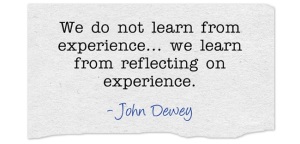Last week, I wrote about the concept of customizable pathway design in online learning. I ended the post by asking three questions:
- How do we document this?
- How do I know that students did what they said they would do?
- How do I know what students are learning or need more help with?
Basically, while I was in love with the concept I was trying to get my head around how to enact it. Thankfully, Matt Crosslin over at EduGeek beat me to it and did some of the hard thinking for me! Matt wrote a great post on Creating a Self-Mapped Learning Pathway that offers some very specific ideas for how students can document what they decided to do within your course. Go read it and then come back here as I’m going to riff on it.
My First Thought: This Isn’t Really That Difficult
Matt’s examples about how students can document their learning are easy to implement. He suggests three tools: blog posts, Storify, and Hypothes.is. I would say think about your students here, there experiences, and where they are headed in the future. For example, if I had a student who already had a well developed blog or who really wanted to learn how to blog, then having that student utilize blog posts could work. I would at least want that to be an option. But, as Matt (correctly) notes, blog posts can be cumbersome because you – as the instructor – would have to be reading through multiple posts and trying to dig up the information you need. You could work around this by having the student pin relevant posts to a pinterest board.
My favorite tool from his list is Storify. It’s simple, and the student simply draws together a list of items with relevant documentation (links, photos, etc…). A blog post tends to encourage people to elaborate. Storify doesn’t do that. Students could make their initial map in Storify, publish it, and then return to it and edit it to add in the documentation showing they did what they said they would do.
Again, I don’t want to keep track of one student’s stories in Storify let alone 20+. I would create a private pinterest board for students to pin their published stories too. This lets me find them pretty easily.
My Second Thought: Creating Reflections
Matt talks about using Hypothes.is as a way to reflect on the path students created (either through Storify or a blog post). I think this also works well. If you see his example, you’ll notice that his reflections (you have to click on the yellow text) are short. He keeps them around a paragraph.
 I think it’s very easy to take any single choice from the pathway and spend a lot of time creating a reflection on it. Maybe you would find that worthwhile, but for me I think keeping it short like Matt has done is the way to go. The other option I would consider is allowing students to make a video where they have their pathway as a screencast and then talk over what they did. I would limit that to five minutes.
I think it’s very easy to take any single choice from the pathway and spend a lot of time creating a reflection on it. Maybe you would find that worthwhile, but for me I think keeping it short like Matt has done is the way to go. The other option I would consider is allowing students to make a video where they have their pathway as a screencast and then talk over what they did. I would limit that to five minutes.
The other thing to consider is how often do you want students reflecting on what they have done and if you want them to reflect on everything. I am not yet sure how many paths I would ask my students to create. But I do know that if they make reflections then I have to read reflections (or watch them if it’s a video). Keeping it short makes it easy for students to do even if they do multiple ones, but I think I would have to balance it out so it’s not overkill over the course of a semester.
This is, in part, what I will be playing with as I move forward in my design. One option I could immediately see is asking students to create a certain amount of pathways but then choose a certain number to reflect on. For example, they created seven paths asking them to reflect on three or four. They could select, but they would need to reflect on the paths within a reasonable time of completing them (maybe within a week). The purpose of reflecting would obviously be lost if they were in the last week of the course and reflecting back on what they did in Week 2.
I’m really excited to have connected with Matt. Definitely go check out EduGeek Journal as I’ve found it to be inspirational for how I think about my teaching.
One thought on “Documenting Customizable Pathways”